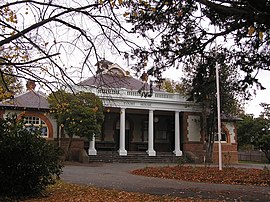Braidwood, New South Wales
Braidwood (35°26′S 149°48′E / 35.433°S 149.800°E) is a town in the Southern Tablelands of New South Wales, Australia. It is in the Palerang Shire. In 2006 there were 1,108 people living in Braidwood.[1] It was used as a location for the movie Ned Kelly starring Mick Jagger in 1969.[2]
| Braidwood New South Wales | |||||||||||||||
|---|---|---|---|---|---|---|---|---|---|---|---|---|---|---|---|
 The Braidwood Courthouse, built in 1901 | |||||||||||||||
| Coordinates | 35°26′0″S 149°48′0″E / 35.43333°S 149.80000°E | ||||||||||||||
| Population | 1,651 (2016 census)[1] | ||||||||||||||
| Postcode(s) | 2622 | ||||||||||||||
| Elevation | 643 m (2,110 ft) | ||||||||||||||
| Location |
| ||||||||||||||
| LGA(s) | Queanbeyan–Palerang Regional Council | ||||||||||||||
| Region | Southern Tablelands | ||||||||||||||
| County | St Vincent | ||||||||||||||
| Parish | Braidwood | ||||||||||||||
| State electorate(s) | Monaro | ||||||||||||||
| Federal division(s) | Eden-Monaro | ||||||||||||||
| |||||||||||||||
| |||||||||||||||
Geography
changeBraidwood is on the Kings Highway which joins Canberra to Batemans Bay on the coast. It is about 200 km (124 mi) south west of Sydney. It is in a highland area near the headwaters of the Shoalhaven River.
History
changeEuropen explorers, Kearns, Marsh and Packer, reached the area in 1822 and the settlers arrived soon after. The town was surveyed in 1839. Gold was discovered in 1851, and over the next 20 years the population grew to about 10,000.
Thomas Braidwood Wilson
changeThe town was named after Dr Thomas Braidwood Wilson.[3] He had been a surgeon on the ships taking convicts to New South Wales and Van Diemen's Land (now known as Tasmania). He was first given land in Van Diemen's Land in 1824, but changed it for land near Lake George in 1825. He was also given 2,560 acres (1,036 ha) of land in the 'new country' on Monkittee and Flood creeks. In 1833 the government took back the western end of Wilson's land for a future village. They gave him more land at the eastern land in return. Wilson moved to the district in late 1836 with his wife and family. He became a community leader. He built the first courthouse in 1837-38. In 1840 Wilson asked the government to build a road from Braidwood to Huskisson for faster and cheaper shipping of wool to Sydney. Wilson and Col. John Mackenzie, supplied the materials and men to make the Braidwood to Nerriga section. In 1841 there were 141 people living at Braidwood Farm. Wilson lost all of his money because of a drought in the late 1830s. He died in November 1843. His land was sold for £2,000 to John Coghill, who now owned most of the land on the south, east and north of the town. Wilson still owned land on a hill north of the town and was buried there in 1843.
A memorial and large pine tree mark the site of Wilson's grave. The path to the grave is open to the public and is through a series of paddocks with gateway sculptures and large art pieces by local artists.
Bushrangers
changeBushrangers, Thomas and John Clarke, killed four policemen near Braidwood in 1867. There is a special monument for the police in the Braidwood cemetery.[2]
Australia's first Royal Commission took place in Braidwood in 1867. It looked at the role of the police in trying to control bushrangers in the area. The Commission found the police were lazy, and in some cases had actually helped the bushrangers. They found that the superintendent of police did not have 'strict and proper control over his men.'[4]
Gold rush
changeBecause of the goldrush the banks and hotels in Braidwood were well built and made to last. It is these old heritage buildings that now attract visitors to the town. Other businesses in the area are sheep and cattle farming, and timber growing.
Braidwood today
changeBraidwood used to be the home of the Tallaganda local government area. However, following changes to local government areas by the New South Wales Government, it is now part of the Palerang council. The eastern office of the council is in the town. The local paper is now called the Braidwood Times.
After the gold rush, Braidwood became a quiet and poor country town. Because of this, very little new building work was carried out, and so the town still has most of its original streetscape and architecture intact. On 30 March 2006 the town and its setting were listed on the NSW State Heritage Register. There were arguments between those who wanted to save the town's old fashioned charm and those wishing to develop it.
Movies
changeThe town has several times been used for movie making locations:
- Ned Kelly (1970)
- The Year My Voice Broke (1987)
- On Our Selection (1995)
- Finding Joy (2003).
Local stories say that Mick Jagger wrote one of his major hits while in Braidwood making the Ned Kelly film; but there is no agreement as to which one.
Related pages
changeReferences
change- ↑ 1.0 1.1 Australian Bureau of Statistics (25 October 2007). "Braidwood (Urban Centre/Locality)". 2006 Census QuickStats. Retrieved 2008-09-22.
- ↑ 2.0 2.1 Lane, Jacqui (2001). The Great Australia Gazeteer. II O'Flahertie, Susan, III Elder, Bruce, IV Thoerning, Peter. Edgecliff NSW: Focus Publishing. p. 38. ISBN 187535980X.
- ↑ "Braidwood". Geographical Names Board of New South Wales. Archived from the original on 4 June 2011. Retrieved 20 June 2009.
- ↑ Report of the Commissioners, State of crime in the Braidwood District, 30 July 1867
Other websites
change- Braidwood Central School website
- Heritage information about buildings in Braidwood Archived 2007-02-09 at the Wayback Machine
- Information about Braidwood Archived 2009-07-28 at the Wayback Machine
- NSW Heritage listing for Braidwood Archived 2008-07-23 at the Wayback Machine
- Palerang Council website
